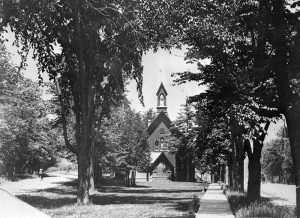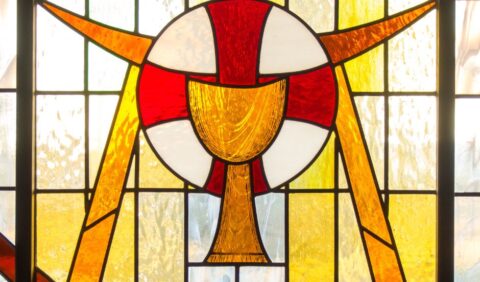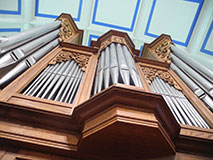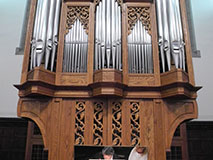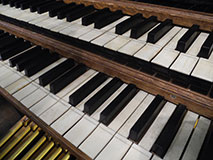For over 150 years people have gathered at Christ Church Deer Park to worship the living God as faithful followers of Christ. We are honored to continue this tradition and legacy today.
The First Church
In 1870 Toronto’s population was about 56,000 and the city extended just north of Bloor Street. The Yonge and St. Clair area, then known as Deer Park, was strictly rural and contained a number of large estates. Yonge Street was unpaved with a single streetcar track up its middle. Every day, a stagecoach ran north to Richmond Hill, with a stop at Deer Park.
At that time there were no Anglican churches between St. Paul’s Bloor Street and St. John’s York Mills. So, on June 6, 1870, a meeting took place and participants agreed to ask the Bishop of Toronto to create a new Anglican parish named Christ Church. The Bishop and Diocese agreed, and land for a church was purchased for one-hundred dollars. On October 5, 1870, construction began. Within 11 weeks a frame building was completed at a cost of $3,000. In 1872, a rectory was built on Heath Street west.
The original parish covered a large area. Its boundaries were Cottingham Street on the south, Eglinton Avenue on the north, Dufferin Street on the west, and the Don River on the east.
The Second Church
In 1909, Deer Park was incorporated into the city of Toronto. The area around Avenue Road and St. Clair was booming and many houses were being built east of Avenue Road. The little frame church from 1870 had served the parish for nearly 40 years but a larger building was now needed.
Construction of a second church, this one of brick, began in 1909 where the original frame church had been located. The old building was repositioned for use as a hall and parish house. Opening services for the new church were held on Thursday, June 2, 1910.
Around 1910, at the request of several prominent Anglicans, the decision to made to move Grace Church — another parish — from its original location on Elm Street to a new location in Forest Hill. This significantly diminished the size of Christ Church Deer Park because the boundaries of Grace Church would run 300 feet west of Avenue Road, north from St. Clair Avenue to Eglinton Avenue, and then west to the ravine and Kendal Avenue.
When this information became public, the Rev. T.W. Paterson, rector of Christ Church Deer Park addressed a memorial to Synod saying,
Naturally, the rich people, to whom so large a free gift was offered, at once petitioned to have a parish formed for them, and this was done. The new parish was taken from the parish of Christ Church, which had just incurred a large debt in the building of a new church to accommodate these very people, and the less advantaged portion of the parish was left to shoulder the whole debt for a church which was now larger than required.
In a subsequent letter to synod he wrote,
Surely the law should be amended which permits the Executive Committee of Synod selling — or practically giving away — the property of one parish to another against the wishes of the rector and the parishioners. Why must Christ Church be sacrificed for Grace Church?
Notwithstanding, Grace Church on the Hill was built.
In 1914 the First World War took centre stage: 131 men and women parishioners of Christ Church Deer Park enlisted and 27 men died in the conflict.
The Present Church
In 1921, to facilitate the widening of Yonge Street, the City of Toronto purchased the property where the second church was located for $92,100. A parish committee recommended the acquisition of an alternative parcel of land at the corner of Heath Street and Lawton Blvd. at a price of $46,918. Vestry agreed and a building committee was formed.
The first sod was turned for the present church in April,1922, and the cornerstone was laid on Saturday, June 17, 1922. A local newspaper reported that a line of choristers and clerics processed from the old church and marched sedately in the rain to a covered platform. As the first hymn was being sung, the rain ceased and the sun broke through the clouds.
The second church was demolished soon after the cornerstone of the present church was laid.
The first services in the new church were held Easter day, April 1, 1923. There were five services: 7 am, 8 am, 11 am, 3 pm and 7 pm. Total attendance was 2,338 and there were 630 communicants. The service of dedication was held on Friday, April 27, 1923.
The Great Depression & the Second World War
The 1930s brought economic problems following the stock market crash of 1929. Nevertheless, the parish was determined to pay off the debts incurred in building the present church. This was accomplished in the 1940s, and on January 18, 1944, the Most Rev. Derwyn T. Owen, Primate of Canada, consecrated the church.
During the Second World War, men and women of the parish served in all branches of the armed services and many died. Christ Church Deer Park was the centre for the Deer Park Women’s Patriotic League. Approximately 110 boys of the 10th Scout Troop collected 510,000 pounds of salvage for the war effort, the best effort of any scout troop in Canada. They eventually raised enough money to buy an ambulance for the Air Force.
Renovation
In the 1990s, Vestry approved a major overhaul of the nonworship space in the church.
The old parish hall contained a balcony and a stage that had seen many parish productions. The hall also had served as a court for a badminton club. All this gave way to a large, bright, open space, more suitable for receptions and large gatherings with a fully-appointed serving kitchen.
The lower hall and kitchen were upgraded and the choir rooms, children’s chapel and small meeting rooms redone.
The main floor entrance and lobby were redesigned and offices relocated to be adjacent to the entrance. Ramps and an elevator were installed to allow access to all parts of the building and new, conveniently located washrooms were installed throughout.
It was a massive undertaking, taken in stride by a vibrant and forward-looking parish.
Remember your leaders, those who spoke the word of God to you; consider the outcome of their way of life, and imitate their faith.
Jesus Christ is the same yesterday and today and for ever.Matthew 22:37
Previous Incumbents
In the Anglican Diocese of Toronto an incumbent is the cleric responsible for the spiritual care of the parish. He or she is appointed by the bishop to perform various church duties for a period of time.
Christ Church Deer Park has been fortunate to be served by incumbents who were deeply devoted to us and who modelled what it means to be true followers of Christ. We bless them and thank them all.
| 1870-1878 | Rector | The Rev. A.G.L. Trew |
| 1878-1922 | Rector | The Rev. T.W. Paterson |
| 1914-1921 | Vicar | The Rev. H. Arthur Brooke |
| 1922-1948 | Rector | The Rev. H.F.D. Woodcock |
| 1948-1953 | Rector | The Rev. Northcote Burke |
| 1953-1967 | Rector | The Rev. F. Arthur Smith |
| 1967-1973 | Rector | The Rev. Fraser Bournes |
| 1974-1988 | Rector | The Rev. Canon Ronald R. Davidson |
| 1988 | Interim Priest | The Venerable G. Ernest Hobson |
| 1988-2002 | Rector | The Rev. Canon R. Timothy Elliott |
| 2002-2003 | Interim Priest | The Rev. David Luxton |
| 2003-2004 | Rector | The Rev. Dr. Rob Pierson |
| 2004 | Interim Priest | The Rev. Canon Duncan Abraham |
| 2004-2010 | Rector | The Rev. Canon Dr. Judy Rois |
| 2011 | Interim Priest | The Ven. Thomas Greene |
| 2012-2016 | Rector | The Rev. Canon Kevin Robertson |
